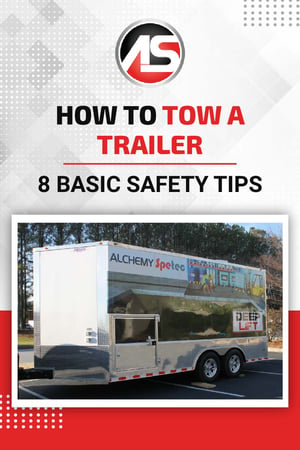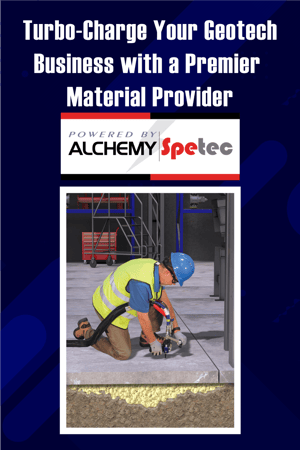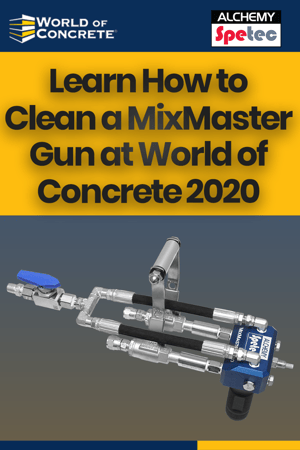
 Whether it’s your first time or you’re a seasoned veteran, this guide can serve as a simple checklist to keep your equipment and 16-20 foot trailer safe as you travel to your next project.
Whether it’s your first time or you’re a seasoned veteran, this guide can serve as a simple checklist to keep your equipment and 16-20 foot trailer safe as you travel to your next project.
Give Yourself Plenty of Room to Stop and Turn
When towing a trailer, the distance required to stop is more than most people realize. The amount of space between you and the vehicle in front of you must be doubled if not more compared to driving without a trailer. The same is true with turns. Allow more space than you think you may need between you and any curbs or other vehicles. And don't jackknife the trailer (a turn so sharp that it touches your bumper) as this can cause damage.
Keep Your Trailer Grounded
Winds, downhill grades, and momentum can all lead to trailer swaying. We recommend utilizing a hitch stabilization device to negate some of these effects. You can also release the gas pedal and manually apply the trailer brakes with a brake controller as needed. Your trailer can start swinging back and forth behind you if you are not monitoring your surroundings and speed.
Look Twice While Changing Lanes
Your blind spots significantly increase with a trailer and it’s much harder to make quick lane changes. Give yourself plenty of space and move slowly from one lane to the other after double-checking your blind spots and the positions of surrounding vehicles.
Patience is Key with Passing
You also have to allow more distance and time when passing other vehicles. Give yourself plenty of room to get your vehicle safely up to speed with the trailer in tow. Be patient and remain calm at all times, even when other drivers may impatiently speed up and pass you.
Avoid Blocking Yourself In
Just because you can get in doesn’t mean you can get out. It’s a lot easier to get stuck or blocked in with a trailer than most people realize. Make sure there's plenty of space to make a complete turnaround or choose a spot where you can exit straightaway.
Practice Backing Up with the Trailer
Backing up with a trailer can be counter-intuitive for newbies. New trailer drivers should take some time in a parking lot or other spacious area to practice slowly driving in reverse. You’ll find that you have to turn the steering wheel left in order to move the trailer towards the right and vice versa. For most people it doesn’t feel right at first, so it’s definitely worth practicing in a safe environment.
Perform Regular Maintenance and Carry a Spare Tire
If you have electric brakes on the trailer, be sure to calibrate them so they are receiving the correct amount power. Follow the calibration procedures in your brake controller manual. Check the lug nuts with a lug wrench periodically to make sure they aren't coming loose. Grease the bearings on the axels every 10,000 miles or once a year, whichever comes first. Carry a spare tire, a lug wrench, and a jack that is strong enough to lift your trailer. It's tough to change a tire without the proper equipment.
Stay Alert
The #1 reason people get into accidents is because they are not paying attention, driving faster than they should, or simply lacking foresight. Look further down the road than you normally would because it takes longer to speed up, brake, change lanes, and turn with a trailer. This way you can spot and anticipate problems from a mile away.



 We understand that chemical grouting is often not the primary focus of a construction or repair job, but a water leak can often bring the rest of the job to a screeching halt until it is sealed. Job costs then start to pile up, production or facility services stay shut down as time drags on, sometimes tempers begin to flare. Sound familiar?
We understand that chemical grouting is often not the primary focus of a construction or repair job, but a water leak can often bring the rest of the job to a screeching halt until it is sealed. Job costs then start to pile up, production or facility services stay shut down as time drags on, sometimes tempers begin to flare. Sound familiar?

 I don’t know what it is about this time of year but for some reason at the beginning of fall we receive the most tech support phone calls from slab lifting contractors. Some of it is related to the changing weather, but this past week several things happened that made me want to address a specific topic – the compressed air system of the polyurethane foam rig.
I don’t know what it is about this time of year but for some reason at the beginning of fall we receive the most tech support phone calls from slab lifting contractors. Some of it is related to the changing weather, but this past week several things happened that made me want to address a specific topic – the compressed air system of the polyurethane foam rig.
 The choice of a polyurethane material provider for your geotechnical contracting business is a critical decision with far-reaching consequences. In addition to top quality concrete and soil repair material, a premier provider will offer reliable high-performance equipment, rock-solid tech support, extensive training resources and even marketing assistance.
The choice of a polyurethane material provider for your geotechnical contracting business is a critical decision with far-reaching consequences. In addition to top quality concrete and soil repair material, a premier provider will offer reliable high-performance equipment, rock-solid tech support, extensive training resources and even marketing assistance.

 Alchemy-Spetec is pleased welcome Colt Hullander! Colt will join us as the new Director of Technical Services – Geotech Division, supporting Alchemy-Spetec customers on a wide variety of polyurethane jobs, from slab lifting to soil stabilization and seawall repair. He brings a decade of geotech experience to the team.
Alchemy-Spetec is pleased welcome Colt Hullander! Colt will join us as the new Director of Technical Services – Geotech Division, supporting Alchemy-Spetec customers on a wide variety of polyurethane jobs, from slab lifting to soil stabilization and seawall repair. He brings a decade of geotech experience to the team.
 Polyurethane – Quality and Selection
Polyurethane – Quality and Selection



.png?width=300&name=Announcing%20Spring%202020%20Infrastructure%20Repair%20Training%20(1).png)

.png?width=1400&name=Alchemy-Spetec%20Fall%202019%20Training%20SOLD%20OUT!%20(1).png)
.png?width=300&name=Alchemy-Spetec%20Fall%202019%20Training%20SOLD%20OUT!%20(6).png)

